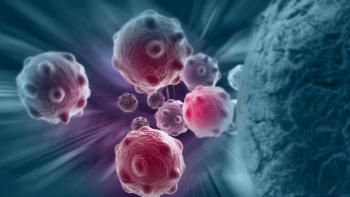
Defining Acute and Chronic GVHD: Signs and Symptoms
A panel of key opinion leaders in stem cell transplant and cellular immunotherapy reviews the hallmark signs and symptoms of acute GVHD.
Episodes in this series

John F. DiPersio, MD, PhD: I want to welcome everybody to the Cancer Network® presentation of chronic graft-vs-host disease [GVHD]. The title of this presentation is “Around the Practice: Chronic GVHD Treatment Advances.” My name is John DiPersio, and I’m from the Washington University School of Medicine Siteman Cancer Center. I have 3 outstanding experts in the field of stem cell transplantation and graft-vs-host disease with me today. I’m going to let them introduce themselves to you all, but the 3 participants will be Yi-Bin Chen from Massachusetts General [Hospital], Hannah Choe from Ohio State University [The James Comprehensive Cancer Center], and Pashna Munshi from [MedStar] Georgetown University [Hospital]. Maybe each of you, starting with Yi-Bin, can introduce yourselves, your area of interest, and your expertise.
Yi-Bin Chen, MD: My name is Yi-Bin Chen. As Dr DiPersio said, I’m from Mass General Hospital in Boston [Massachusetts]. I’m a clinical researcher, spending most of my time taking care of transplant patients. I have an academic interest in improving outcomes, including patients with graft-vs-host disease.
Hannah Choe, MD: I’m Hannah Choe, I’m a BMT [bone marrow transplant] physician, a clinical and translational researcher at Ohio State University, The James Comprehensive Cancer Center [in Columbus, Ohio]. I specialize in graft-vs-host disease in particular.
Pashna N. Munshi, MD: Hi. I’m Pashna Munshi, 1 of the bone marrow transplant physicians at MedStar Georgetown University Hospital in Washington, DC. I love all things related to stem cell transplantation. My clinical research interests are patient outcomes and caregivers alongside going through the transplant process.
John F. DiPersio, MD, PhD: Thank you, everybody. We’re going to spend about an hour discussing some of the issues with diagnosis and treatment of patients with chronic GVHD. These represent, in my humble opinion, some of the most challenging clinical issues that we deal with in the transplantation community. There are many things that we’ll say about the lack of really good hard-core diagnostic criteria for progression. Unfortunately, 1 of the messages at the end of this will be that we all wish we had better quantitative measurements for the activity of this process that we call chronic GVHD. It’s a problem when we’re looking at treatment interventions. Also, we don’t understand that much about the biology of the disease. But we’ve made some progress. Patients suffer from this, and sometimes this disease can be worse than the original leukemia they come to transplant with.
I’d like to discuss some issues related to specific case presentations and ask my colleagues how they would manage these issues. The first point relates to defining acute and chronic graft-vs-host disease. We can start with Yi-Bin. What are the classic signs and symptoms of acute and chronic graft-vs-host disease? What organ systems are affected?
Yi-Bin Chen, MD: We tend to view acute and chronic graft-vs-host disease as separate diseases. For the most part, they’re separated in time by their onset after transplantation and their manifestations. Historically, we had this day 100 mark: acute would occur before it, and chronic would occur after it. With the heterogeneity and how we do transplant these days, that timeline doesn’t matter anymore. It’s much more about the clinical manifestations, how you diagnose the distinction between acute and chronic. And then, there are rare cases where you have patients who have overlap symptoms of both, and that does happen. But we tend to view acute graft-vs-host disease as a T-cell–driven immune response, and the organs we think about it affecting include the skin, in terms of erythema or red skin rash. The lower GI [gastrointestinal] tract is the most serious complication, resulting in the most morbidity and even mortality. That presents as diarrhea. Some upper GI tract involvement can be anorexia, lack of appetite, or persistent nausea. The organ that’s least likely to be involved is the liver, mainly presenting as asymptomatic elevations and liver function tests. Those are the primary organs we look at for acute graft-vs-host disease.
Chronic is much more indolent. It takes a longer time to develop. Instead of a classic T-cell response, we think there’s a role for B cells, regulatory T cells, and other immunological pathways that are often redundant. The manifestations are no longer this angry rash and diarrhea. They’re more dominated by symptoms we find in classic autoimmune disease: their eyes are dry; the mouth is very dry from lack of salivary production, and there can be ulcerations; the skin is no longer an erythematous rash but looks more like eczema or psoriasis. Almost any organ can be involved. This includes the lungs, the fascia, the underlying connective tissue of the skin, the joints, and the muscles. It’s a very heterogeneous disease, which has made progress quite difficult in this chronic graft-vs-host disease entity.
John F. DiPersio, MD, PhD: That was a great overview. Pashna, I wonder if you could elaborate a little, especially on some of the symptoms and the onset of these symptoms of chronic graft-vs-host disease.
Pashna N. Munshi, MD: As Yi-Bin put it, they’re very different from the presentation of acute GVHD, where the hallmark is this red rash. Chronic GVHD is a little more subtle in my opinion. Sometimes it can creep up on you or your patient without them even knowing that they have a disability, but symptoms like oral pain, dry mouth, or taste changes are more apparent. They’ll tell you right away that my mouth is burning, things are sensitive, there are ulcers, or that their eyes feel dry. But once the chronic GVHD builds up more in the myofascial and the skin, things like skin tightening—especially if they’re a little overweight—might be missed. Sclerosis could be developing, and they may not know that they have a patch of sclerotic myofascial skin in the abdomen. If you ask them to raise their arm over their head or to get something out of the kitchen drawer, if they haven’t done it for a long time, they’ll realize they’re not able to do that anymore. Chronic GVHD is a very subtle phenomenon. As experts, we’re always looking out for it, but many patients may be home with their referring docs in the community. Otherwise, things can be missed.
John F. DiPersio, MD, PhD: I have a rule that goes like this. Anytime you’re taking care of a transplant patient late after transplant and something completely odd is going on, always attribute it to chronic graft-vs-host disease until proven otherwise. It’s almost always true because there are many things that can happen, with joints, fashion, skin, and liver, but also pleural and pericardial effusions. Odd things can also happen, like nephrotic syndrome. All sorts of things can happen that are quite odd, but sometimes they smack of these overlapping connective tissue diseases. With them you can get some of these polyserositis symptoms that are really annoying for a patient’s edema.
Transcript edited for clarity.
Newsletter
Stay up to date on recent advances in the multidisciplinary approach to cancer.






















































































